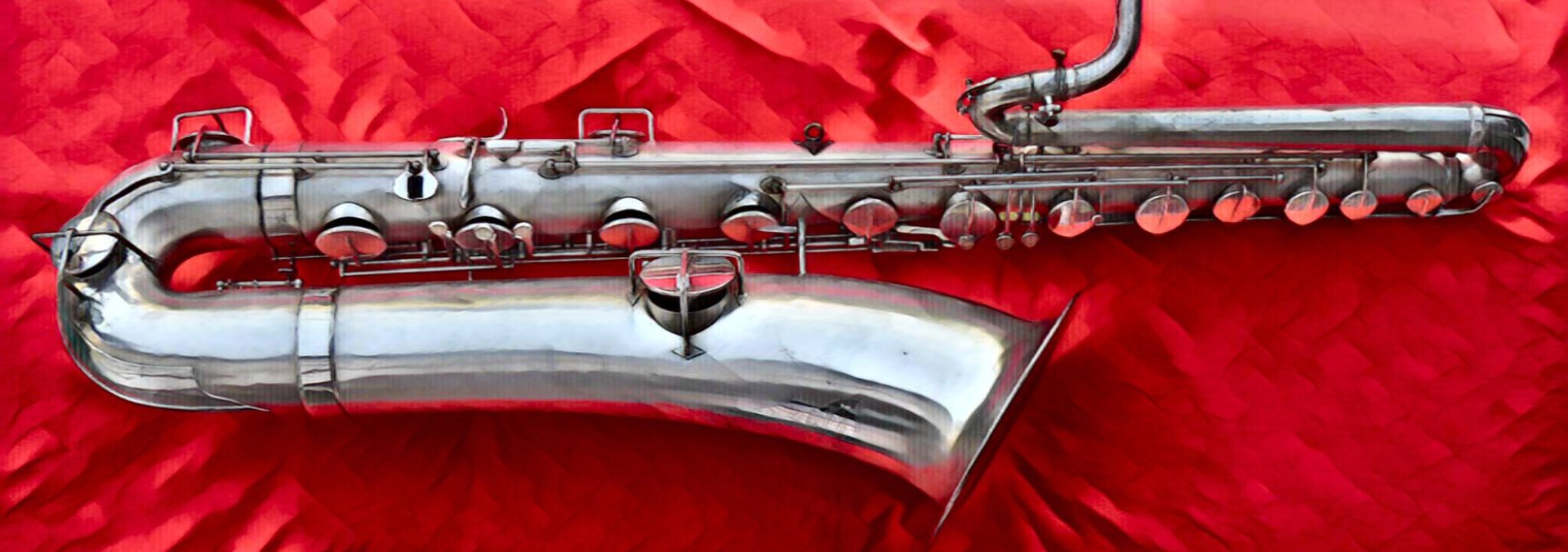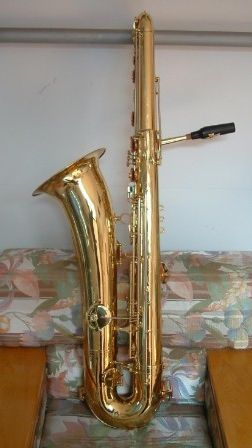Well it appears that another Asian-made, American-style bass saxophone is available. Or might be available. Or could be, if enough people sign up for it.
This morning, in a thread on the Woodwind Forum, it was brought to my attention that Aquilasax had a bass saxophone on its site. It appears that maybe the stencil name that this Jinyin-made bass is being sold under, is Solo.
Source: aquilasax.3dcartstores.com
This is how this horn is described:
Bass sax Bb
Part Number BassaxSOLO
Traditional bass sax made in Beijing. I played one briefly and found it to be big. Felt a bit like my Conn baritone but bigger. Looked a bit like a Conn too, similar keys. Big sound! Email Steve if interested?
Since the instruments are currently not in stock, and the price is showing as $0.00, I’d say he’s gauging interest to see if he’s got enough people to warrant ordering some in.
I don’t know about you, but I find it curious that Steve would even try and float this. He is after all, the king of new saxophones in the key of C—with perhaps a foray into the key of F.
In any event, given that I’m trying to stay on top of what’s new in the world of bass saxes, I wouldn’t be doing my job 😉 if I didn’t at least mention this. Stay tuned, tomorrow we’ll take a closer look at Steve’s other bass project.




If Steve is just ordering them on an as-needed basis, and shipping them straight to purchasers from China (which I know he does with the C-Mels, and it’d be even more stupid to ship a bass twice), then there isn’t much risk involved. Besides, he sells a fair number of conventional altos, tenors, and sopranos already. It’s not like he’s betting the house on C instruments. This is good, considering the difficulties he encountered getting the C-Mel into production (and arguably beyond).
I didn’t know that Steve deals in altos, tenors, etc. I thought he only dealt with C-pitched instruments. In this case yes, it makes sense that seeing if he had enough orders for some bass saxophones makes sense. It wouldn’t be any risk to him.
However, given that Jinyin horns have not got the best track record, I would be more inclined to have gone with Jinbao-made horns–especially if as you suspect, they’re not being checked over, and regulated in house, before being sent out to buyers. Jinbao are overall regarded as the superior of the 2 brands in many ways, including build quality, which also explains their much higher price tag.
I didn’t say they’re not being checked over in house. I have evidence that they ARE being checked over, sometimes by Steve personally and sometimes by others — my C-mel was QC’d by Steve himself. It’s just that the PEOPLE go to China, rather than the horns going to New Zealand.
Unfortunately, I don’t think Steve is a good enough player to know a merely decent horn from a good or great one, and maybe even not enough to distinguish a merely functional horn from one that’s actually useful. The C-mel I bought had a neck that played badly out of tune and had poor palm key response — which Steve willingly replaced. Still I had to add strategic hot glue to the inside of the SECOND neck to fix intonation (the response was OK), and there were certain notes (side Bb most notably) that just couldn’t be coaxed into tune by any means short of enlarging the hole in the tube and soldering on a new tone hole. The three different Bb’s (1+bis, 1+1, and 12+side) were all completely different pitches. 1+bis is always sharper than 1+1, that’s to be expected when you close extra holes downstream, but 12+side should be spot on every single time. (As for the hot glue trick, I’ve used it on other horns when the neck is clearly too wide at some point due to previous repairs, because it’s invisible and reversible. Just stick a rag in the neck, heat it up, and yank the rag out with the glue in it.)
I bought it because it had modern mechanics, thinking I could tame its alto-like Conn sound. I never did, and the mechanics frankly weren’t all that good! There were inadequate clearances between moving parts that could pinch fingers, and lots of slop in the mechanism, particularly the octave mechanism. One of the pads fell out too, which is when I saw it was only barely glued in with rosin, leading me to casually pry on other pads and see if they’d pop out too (a few did). The intonation was just all over the place to boot. My 1919 Buescher had far superior intonation once I got a 1923 neck on it (it was horrible with the original neck, and so was the response, which is why I knew the Aquilasax’s neck was also to blame). Then I modified the 1919 neck to behave more like the 1923, and paired it with the 1923 body for resale. Both horns ended up playing better in the end, but the 1919 definitely did better. The 1923 was probably just as good of a horn, but it needed new pads and I hadn’t already tweaked the left pinky cluster to my liking.
In any case, I’m not saying I wouldn’t buy an Aquilasax instrument again. I do think he learns from previous mistakes and listens to his clients. I just don’t have any desire to be an early adopter.